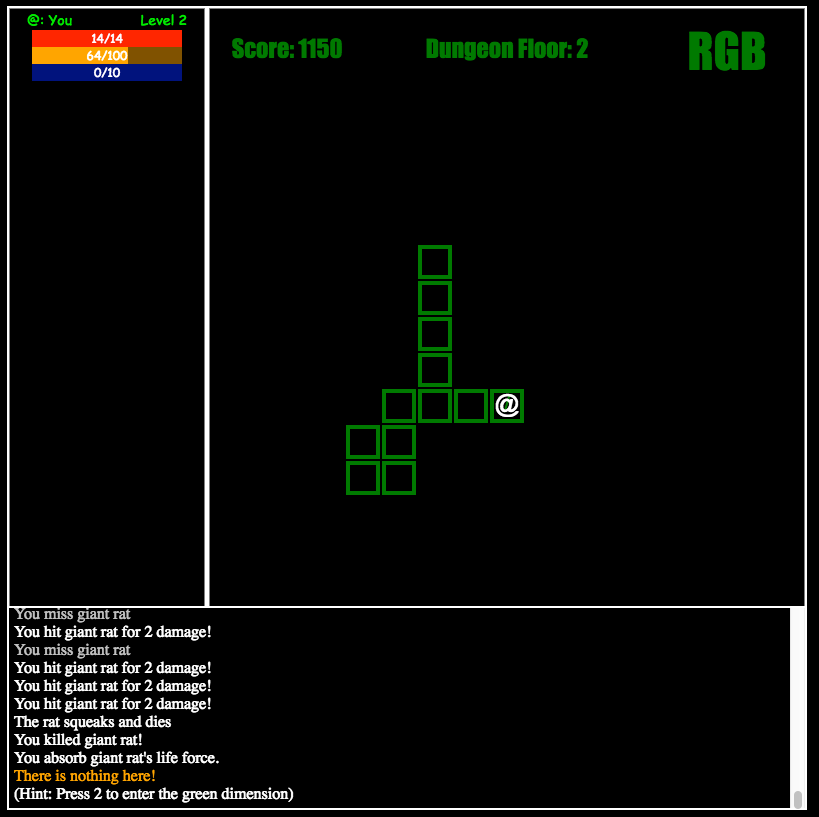In which I finish my first game
Description
The Seven Day Roguelike challenge (7DRL) has been an annual competition since around 2005. The premise is simple: create a roguelike game in seven days!
From wikipedia:
Roguelike is a subgenre of role-playing video games characterized by a dungeon crawl through procedurally generated game levels, turn-based gameplay, tile-based graphics, and permanent death of the player-character.
I, like many developers before me, have a long history of half-started games stretching back to middle school (our half-finished Pokemon clone on the TI-83+ was legendary) so the concept of actually finishing something was very appealing to me. I teamed up with a friend and we were off!
 Gotta love those rats
Gotta love those rats
Our idea was somewhat simple: create a simple dungeon crawler in which you could shift between three dimensions (red, green, blue - hence the name of the game). Initially we were thinking you could gain experience in a dimension for staying in it longer but in the end we made it so that each dimension had its own “special move”.
 Our helpful hint to switch dimensions
Our helpful hint to switch dimensions
It’s not the most beautiful or robust (there is a still a bug when going to the next level that I haven’t figured out yet) game in the world, but we made it in seven days! From scratch. Take a crack at it now! If you get to level 10, consider yourself an RGB champion.
 You’re green!
You’re green!
Code
RGB is played in your browser and uses a combination of html element and canvas to render. We wrote everything from scratch, including the game engine, which was quite the learning experience. You can view the code on github.
The encapsulation wasn’t the best, Game.js touches rendering, creep ai, input, game logic, and display but I think it was pretty decent for seven days of work.
Perhaps some of the most gnarly code came when we implemented Dijkstra’s algorithm to help our creeps move a little more intelligently. You can see our very simplistic creep ai here:
takeCreepTurn: function(creepController, dijk, closeQuartersDijk) {
// attack logic if we are in this dimension
if (creepController.isAdjacentToHero()) {
creepController.attackHero();
} else if(creepController.aggroHero()) {
// Prioritize closeQuartersDijk if it has information
var next = closeQuartersDijk.getNextTile(creepController.getCharacter().getLocation());
if (!next) {
next = dijk.getNextTile(creepController.getCharacter().getLocation());
if (next)
console.log("Dikj is telling me to go to", next.toString(), 'from', creepController.getCharacter().getLocation().toString());
}
else {
if (next)
console.log("closeQtrDikj is telling me to go to", next.toString(), 'from', creepController.getCharacter().getLocation().toString());
}
if (next) {
var dir = creepController.getCharacter().getLocation().directionTo(next);
if (creepController.canMove(dir)) {
creepController.move(dir);
} else {
// Dijkstra should never tell the creep to move where it can't BUT just in case it does
this.doBestAdjacentMove(creepController);
}
} else {
this.doBestAdjacentMove(creepController);
}
}You can see we borrowed heavily from battlecode’s api with creepController and canMove. Had I actually made a creepPlayer things might have been much cleaner (and different creeps could have different ai / behaviors).
Results
RGB was a success (by 7DRL standards)! We were even featured as the 7DRL of the Day on reddit and was reviewed a couple times in the 7DRL Reviews (thanks to Jabberwock and Yeti for taking the time!) and given an overall score of 2.2 (out of 3)
“RGB is a browser roguelike with an interesting multi-dimensional mechanic. Red Green and Blue all operate as separate dimensions of the same dungeon. After the first three levels, where switching is mostly useless and/or instant death, the mechanic becomes very interesting! You can only attach enemies in your same dimension, but you can use other dimensions to escape. The level colors are a bit over-bearing but the dimension switching is cool!” - Yeti
Over the years RGB has seen surprisingly more play than I expected. I’m not sure who was playing everyday in the summer of 2015, but whoever you are, I salute you! We’ve had players from 48 states (North Dakota and Alaska, looking at you) and there have been close to 4000 sessions in the two years since.
